Smart cities: India
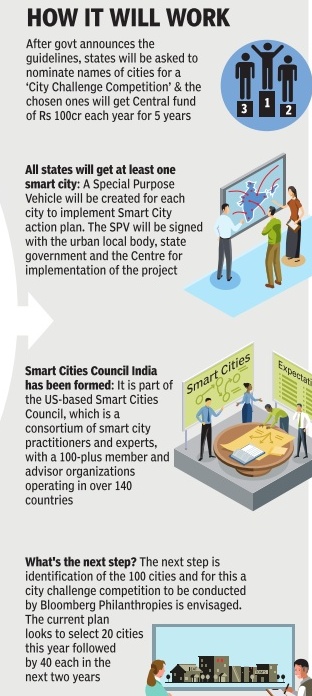
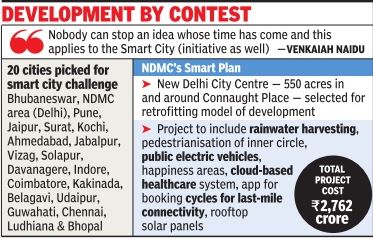
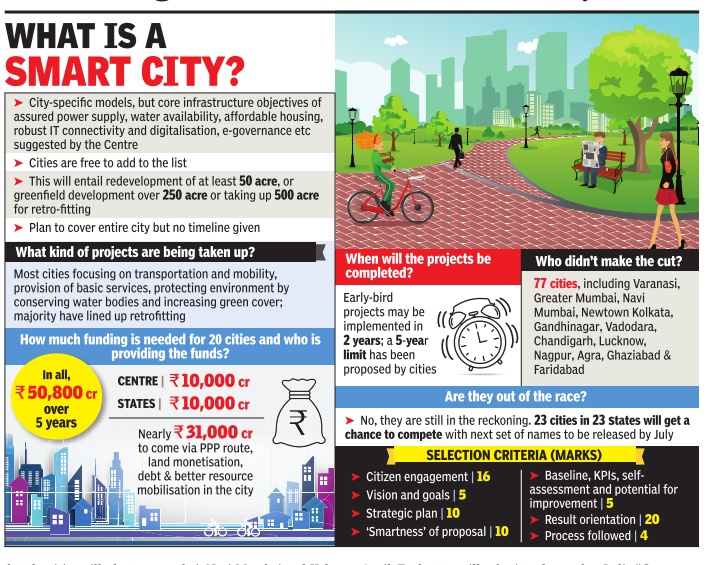
This is a collection of articles archived for the excellence of their content. |
Contents[hide] |
Mission smart city
The Times of India, May 02 2015
Prime Minister Mr. Narendra Modi had announced his vision to set up 100 smart cities across the country soon after his government was sworn into power mid last year. Since then a race has been on among cities to land on the list that the ministry of urban development is compiling. The 100 smart cities mission intends to promote adoption of smart solutions for efficient use of available assets, resources and infrastructure. Dipak Dash explains what these smart cities are and how they will work
What is a smart city?
The vision, explained in a graphic
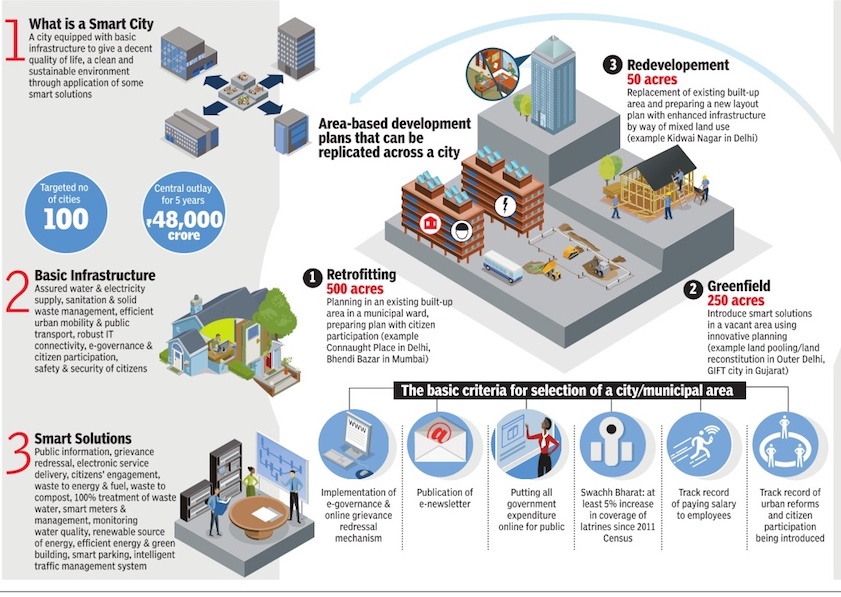
See graphic:
What is a smart city?
Efficiency of cities is more than rural areas
Laveesh Bhandar, Dec 1, 2014: India Today

From:Laveesh Bhandar, Dec 1, 2014: India Today
Finally, and thankfully, realisation is steadily gaining ground that India needs to do something about its cities. Desi cities have suffered for many decades from misguided prioritisation advised by the leftist and socialist intelligentsia, and followed by Nehruvian politicians. All great civilisations have grown, prospered and died with their cities. Indians should know this more than anyone else.
Yet we have the distinction of systematically throttling our cities. It starts from the strange notion that for India to grow, its rural areas need to grow and prosper but not its cities. Gandhiji may have said India lives in its villages, but he definitely would not have advised the elimination of progress in all of urban India. The rural and urban are parts of the same body, where one part cannot prosper without the other prospering.
Cities are like the root of a tree, they are able to more efficiently provide innovation, funds, human capital, safety, justice, freedom and a multitude of other components that go into human progress.They are able to do this because unlike smaller habitations, a greater variety of people can meet and interact in larger numbers and with greater frequency.
Interestingly, cities do all this far more efficiently than smaller habitations. Take land use for instance. An average village resident uses up far more land than an average city dweller-as is reflected in greater population densities in larger habitations. Moreover, if cities did not grow, people would use up far more of the productive land in rural areas. Villages tend to be set up near the best source of water and that is also the most agriculturally productive land. Villages can also be quite polluting, we just do not see it. The use of fertilisers and pesticides, burning of agricultural waste, diesel water pumps are only a few examples. In other words, villages and cities both have a similar set of problems, it's just that in cities they are more visible. The potential advantage in cities is that a variety of people can come together to solve such problems more frequently. The previous government did not understand anything about cities, and mindlessly tried to come up with programmes for building more infrastructure. Infrastructure is obviously important, and so is the use of the latest technologies in telecom or internet communication, transport and construction. But those will also by themselves not make great or smart cities.
The critical differentiator lies in the services a city needs to provide-sewage, garbage collection, public transport, law and order, traffic control are the key examples. But in improving these, the current Government will come across a major hurdle. It is easy to mandate infrastructure creation, and is far more difficult to mandate and achieve service quality sustainably. Recall that service quality improved significantly during the Emergency era, which was also a top-down approach similar to that currently being followed. But its benefits did not last.
Currently, most cities have extremely poor services, because those that provide the services are not answerable to the elected representative of their areas at all. Typically, the chain of command goes all the way to a bureaucrat, a municipal commissioner in larger cities, who eventually reports to the chief minister. Across all states, therefore, wherever the CM resides, all public services are of very good quality. The solution is to give the city back to its people. Let there be a city-level mayor, elected by the people of that city, and answerable to them directly. Let democratic processes ascertain how taxation will be undertaken, how such revenues will be allocated, and what will be the vision for each city. Let the municipal commissioners take orders from the mayor, and not the chief minister. But the PM and the Government will need to give a larger vision even to the new empowered mayors across the 8,000-odd cities spread across India. The term 'Smart City' will need to be given a face for people to try and emulate. What could be that mantra?
PM Narendra Modi intuitively understands the importance of public spaces. The Sabarmati riverfront or the ghats of Varanasi are not just places of entertainment and leisure, they bring people together. Markets are another place where all types of people congregate. But in Delhi, the Government has been systematically eliminating weekend haats, and unorganised markets which both rich and poor use, while allowing new malls which only the rich can. Interaction is also about enabling travel within the city-the British built wide footpaths everywhere including in Kolkata, Mumbai and New Delhi, but after Independence, someone up there forgot that people need to walk on roadsides.
The diversity of its people is another extremely important element of a successful city. New York and London are classic examples of how economic and intellectual richness flow naturally out of the sustained interaction of diverse people. In India, Kolkata floundered when non-Bengalis started leaving the city; Mumbai prospered when others entered; Delhi simultaneously lost and gained from the churn during Partition, and Bengaluru has no doubt gained from the in-migration of people from all parts of the country.
But we need to do more. Interaction and diversity will be best served when Indian cities have adequate space for the poor. No, do not put them in illegal slums, or in cramped high-rise buildings as some cities are proposing, but in areas where their children can play freely, where women can walk unhindered, and where open space allows a free line of sight for both mothers and policemen. Perhaps, that could be Modi's mantra for smart cities.
The reality: the priorities of the planners
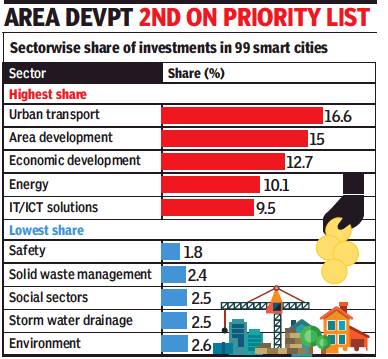
From: Radheshyam Jadhav, Smart cities let transport take lead, put safety & waste disposal in back seat, July 10, 2018: The Times of India
Transport Gets 17% Of Funds, Garbage 2%
While urban transport is the topmost investment priority for cities selected under the Centre’s Smart City Mission, safety and solid waste management issues are at the bottom of the list.
In a presentation made to the parliamentary standing committee on urban development, the housing and urban affairs ministry has stated that 99 cities that are part of the mission are expected to make investments of Rs 2 lakh crore, of which the highest share, of over Rs 33,000 crore (16.6%), is proposed for urban transport.
Interestingly, while most cities in India are faced with a solid waste management crisis, only 2.4% (Rs 4,896 crore) of the total investment is directed towards this sector. Social sectors and storm water drainage are also a low priority on the investment agenda with just 2.5% (Rs 5,100 crore each) for projects in these areas.
Some of the core infrastructure elements in a Smart City include adequate water supply, assured electricity supply, sanitation including solid waste management, efficient urban mobility and public transport, affordable housing and safety and security of citizens, particularly women, children and the elderly. While many of these components are also covered and funded through other programmes like AMRUT and Swachh Bharat Mission, cities were free to also include them in the Smart City drive.
After urban transport, area-based development is the second most important priority, with proposed investment of Rs 30,600 crore. Under areabased development, cities pick one area and develop it fully so that the model can be replicated in other parts of the city.
According to the ministry, 3,183 projects worth Rs 1.45 lakh crore are in various stages of implementation. Projects worth Rs 4,960 crore have been completed. Work has begun on other projects worth Rs 23,000 crore while the tendering system is in process for the rest.
The Smart City Mission is one of the Modi government’s flagship programmes. The mission’s duration is five years — 2015-16 to 2019-20 as per the mission statement and guidelines, which add that it may be continued thereafter after an evaluation.
National Smart City Award
2023
Dipak Dash, August 26, 2023: The Times of India
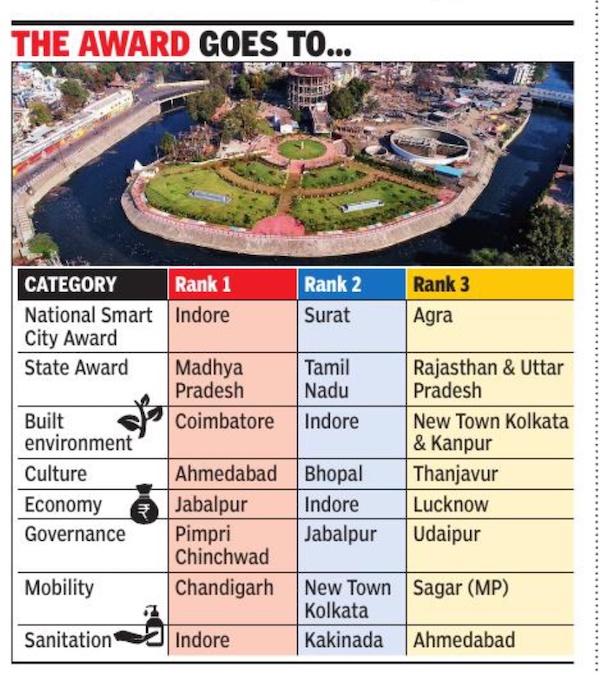
From: Dipak Dash, August 26, 2023: The Times of India
New Delhi: Indore, which has been the cleanest city for the past six years in a row, got another feather on its cap to bag the best “National Smart City Award” of 2022, for exemplary performance among the 100 smart cities. Surat and Agra have emerged as the second and third winners among the cities in the fourth edition of India Smart Cities Award Contest (ISAC).
As per the results of last year, which were announced on Friday, Madhya Pradesh and Tamil Nadu have emerged at the first and second best performers respectively among the states while Rajasthan and Uttar Pradesh have jointly bagged the third slot. Among the Union Territories, Chandigarh has got the highest score.
In an official release, the housing and urban affairs ministry said President Draupadi Murmu will felicitate the winners on September 27 in Indore. Though officials said that Indore has been the top performer in all the missions of the urban affairs ministry, the results come at a time when Madhya Pradesh is heading for the assembly polls and may be a shot in the arm of Shivraj Singh Chauhan government to showcase these achievements to counter anti-incumbency.
Interestingly, the NDMC area in Delhi, which falls under the central government and is one of the municipal areas selected for Smart City, has not bagged any award under 12 different categories. Sources said NDMC did not participate in the contest.
In the last contest in 2020, Surat and Indore were announced as the joint winners of the best smart cities. The results for ISAC were not announced for 2021.
Among the cities, Indore bagged six awards; followed by four by Agra; three each by Surat, Ahmedabad and Chandigarh, and two each by Jabalpur, New Town Kolkata andRaipur. Out of the total proposed 7,938 projects under the scheme, 76% worth Rs 1. 11 lakh crore have been completed and the remaining 1,894 projects will be completed by next June.
Role of technology
Urban areas
Amulya Gopalakrishnan, dEC 1, 2014: India Today
Would you like to live in a smart city? One where efficient city systems work quietly in the background, taxing you minimally? Factories would automatically spot glitches and fix them, hospitals would regulate medical devices remotely, and lighting and temperature in a hotel would mould themselves to your preference.
To some of us, already used to pointing our phones in the air to identify a song, or controlling smart thermostats, this future may seem very close. To others, struggling to make a decent life in the city, this vision may seem indistinguishable from magic. A full quarter of an Indian city lives in slums-in Mumbai, half the population does. The press on land and housing, the scarcity of piped water and sewerage, forces informal "adjustments". In a context where even tech havens like Bengaluru struggle to dispose of their waste, the smart city can seem like a distant neverland.
A smart city involves the blending of technology and big data to improve civic decisions. Masdar City in the UAE, Songdo in South Korea and Plan IT Valley in Portugal have been planned like the platonic idea of the smart city, where sensors and cameras track buildings, roads, public spaces and vehicles, adjust settings to uses, and direct the delivery of services.
Though they cannot replicate these islands of efficiency, many big cities have incorporated "smart" elements. In Rio de Janeiro's Operations Centre, a wall of screens keeps officials updated with live information from 560 cameras, a weather forecasting system, and a smart map that can analyse 60 layers of data from around the city. Singapore aims to be a "smart nation" with pervasive connectivity and intelligent infrastructure. Mumbai, too, is experimenting with adaptive traffic signalling.
PLANS AND BLUEPRINTS
The smart city has been a particularly contagious buzzword, informing policy around the world. And of course India wants a part of the smart. The Narendra Modi Government plans to invest over Rs 7,000 crore to build 100 smart cities, with private and international collaboration. But rather than succumbing to dizzy futuristic visions, the Centre's vision is practical, and signals a welcome recognition that urbanisation has reached a historical threshold in India. In fact, it seems to have grafted the word "smart" to a range of necessary improvements in institutional and physical infrastructure. The urban development ministry's concept note talks of making selected cities investment-friendly, with better housing, 24-hour water and electricity supply, sanitation, clean air, education, health, security, entertainment, sports and mobility. It talks of smart grids, medicities and startup incubators, and the use of ICT in administration. More technology and private participation is implicit, but it is not the centre of these plans.
"But only technology can bring great change, look at any society that has made great progress. We have great engineering and software talent, why not exploit it for our cities, for the common man?" said Shankar Aggarwal, secretary for urban development, explaining the smart city rationale at the LSE Urban Age conference recently held in Delhi. "Using technology for better services is a no-brainer, like say, RFID (Radio Frequency Identification) tags for garbage, better land records, real-time traffic monitoring and so on," says Jagan Shah, director of the National Institute of Urban Affairs, which is helping the Government flesh out its plans. "This could also be a way to harness information about the processes of the city and the government, to make more evidence-based decisions, to target social programmes," he adds.
Shah lays out a vision where technology could help cities make better use of their own economic competence, and where the city could pool resources and ideas from the Centre, state, industry consortia and civil society. He acknowledges that it won't be easy, given the weak authority of urban local bodies to make most of their own decisions. "But how can we turn this scepticism into optimism? That's our challenge," he says.
Aware of the risks of trying to create new cities out of thin air, the Centre is merely planning to add an informatics layer for existing cities. But around India, other smart city experiments are already in the works. Upcoming towns along the Delhi-Mumbai industrial corridor, Dholera in Gujarat, Shendra in Maharashtra and Manesar in Haryana are being laid out with integrated smart infrastructure. Some municipalities have signed individual contracts with private companies to step up their game in digital service delivery.
Mumbai policemen monitor traffic using technology developed by a World Bank-supported transport project
THE BUSINESS OF SOLUTIONS
Companies such as IBM, Cisco, Siemens and Microsoft, which supply the rhetoric, maps and hardware for much of this work around the world, have a grander view of the future.
An IBM video explains traffic gridlock with an animated video, where a city is represented with a bird's-eye view of bright coloured dots darting rapidly along a grid. The voice over explains how we gather huge amounts of data from tollbooths, traffic patterns, eyewitnesses, fares, meters and camera, how this is now siloed in different departments and agencies, and how smart cities will aggregate and use that information for the greater good.
Siemens envisages a city cockpit, an "integrated management, information and decision support system" to assist authorities track performance indicators in traffic, environment, finance and other areas.
Says Anil Menon, president, Smart+Connected Communities at Cisco: "After the waves of globalised IT and engineering services, global public services could be India's big boom." He describes the ways this is already happening, like when hospitals in the US rely on diagnostics and analytics from India, or wealthy farmers hook up to investment advice in faraway locations. Cisco, he says, is a provider of digital architecture that can either work with service providers for a share of the revenue, charge a fee, or provide end-to-end solutions.
The company, which is in the business of providing circuits and switches, collaboration suites and cloud services, also runs a consultancy to help city administrators identify their needs and create funds. "For instance, we've just started a pilot project with the Bengaluru Police to run a kiosk in a mall, where FIRs can be electronically filed. Take another example, of how parking can be made smarter with an app on your phone that tells you where the empty slots are, reducing the need to drive around, reducing congestion," says Menon.
I SMART IS WHAT SMART DOES
These high-concept plans promise to predict crime, avert accidents, save energy and make city living a glide. "But what looks good on a PowerPoint or a lab or even a building is not the point, it needs to work for 10 million people," says Srivatsa Krishna, secretary of information technology, biotechnology and e-governance, Karnataka. Technology, by itself, is neither good nor bad-its effects depend on social uses. It is up to those who decide for cities to choose the ends they want to serve and the tools that might aid them.
"I applaud the idea of smart cities, if it addresses what Indian cities really need. There are certain basic conditions of urban life-access to health, housing and work. Can the technology being considered solve or ease any of those problems?" asks Ricky Burdett, urban studies professor and director, LSE Cities. In a situation where the sewerage network only extends to 30 per cent of urban citizens, policymakers must weigh their priorities carefully, he says. Faced with real challenges of large-scale migration, effective land use, water and waste, transport and mobility, cities need much more than a technological fix.
While it is important to improve services, we must not make a fetish of the delivery mechanism alone, and must consider the action being accomplished, says K.C. Sivaramakrishnan, former urban development secretary and chairperson, Centre for Policy Research. "Earlier, to collect property taxes in Chennai, a bunch of people would go to homes and make you fill forms. Now, that work is done on handheld devices, but it doesn't change anything fundamental. In Surat, the commissioner is given a daily picture of garbage disposal and water supply from every municipal ward-though it may be done by officials rather than a technology." In his view, incorporating informatics is not a big deal if one disaggregates services and thinks of how to improve each of them, but a "sense of realism in our targets" is the crucial thing.
TRUST SMART CITIZENS
Others have countered the boosterism around smart cities in serious ways. For instance, are we ready for an elaborate mesh of sensors and cameras recording us, companies or administrators silently gathering data about us, in a context where privacy protections are so weak? There is every chance that law-enforcement officials will claim these technological affordances to avert crime or terrorism. But that also leaves open the possibility of personal information being used without the knowledge or consent of citizens. This is not hard to imagine; think of the way Delhi Metro CCTVs were recently used to ogle affectionate couples and make porn clips. Cities, where we go to find freedom and anonymity, can close in on us too.
What's more, the uses of technology are wayward and unpredictable, and a city's needs cannot be programmed in advance. "Technology evolves faster than cities-if you install a system in 2012, it will be obsolete by 2016," says Adam Greenfield, urban scholar and author of the book Against the Smart City (The City is Here For You to Use). Greenfield and others are wary of off-the-shelf solutions to anticipate and control urban life.
They are not downbeat on technology, which will inevitably inform civic life, and is already doing so. "You don't need to install sensors and processors and pay for their upgrade and maintenance. Look at apps such as Street Bump, that can use GPS and the accelerometer on your phone to identify potholes." Rather than locking citizens into a top-down mandated system, they advocate leaving the technology open, having a deeper interactivity between devices, and giving people control over their own data. "Free wi-fi would be a smart, people-friendly tech," says Greenfield
Smartphones are indeed supple tools, and can achieve many of these efficiency goals. For instance, in Bangalore, if someone finds a non-working streetlight or a pothole, he/she can take a picture with a phone and send it through the Karnataka MobileOne app, which can direct it to engineers. Payments of property taxes, utilities, booking tickets can also be done on the phone, even dumb phones, through USSD (unstructured supplementary service data).
"Mobile is digital and modular," says Srivatsa Krishna, and it allows people to apply their own ingenuity, rather than being the consumers of big wall-to-wall visions. "The engine of a smart city will be smart people, and the different combinations of ideas that people can come up with to create localised services," he says. Initiatives such as Code for Karnataka are an attempt to direct that energy.
LET CITIES THINK
At a deeper level, this debate over smart cities boils down to a philosophical argument between advocates of ambitious, all-encompassing planning and those who think that a city's solutions are best generated internally on smaller scales. Sociologist and urbanist Richard Sennett described his experience in a high-tech city control room, where, when the tech guys explained how traffic could be reduced by connecting two points, the mayor asked: "But how can we cut that community in half?" In other words, says Sennett, planning must be socially smart, and not just concerned with the shortest distance between two points. "How can technology be more responsive, not to conditions on a map, but to how people live?"
The Centre's plan, while still embryonic, does allow individual cities to decide their own priorities. The outcomes will depend on who does the choosing-a local government, citizens' groups or private consultants. As Gerald Frug, professor of law at Harvard University, says, smart cities need smart states. In India, devolution of political power to cities, envisaged by the 74th constitutional amendment, has been thwarted; most of them cannot raise their own revenues or manage their own functions. Having elected mayors, as some states do, has been advocated by some, but more importantly, city governments need more financial autonomy-and there are many ways the Centre could spur that freedom. As Frug says, "For cities to be smarter, they need to be given a brain, allowed to make their own decisions rather than being ordered like robots." If India is serious about smart cities, they must be given the crucial capacity to think and act for themselves.
Smart city list
The Times of India, Aug 01 2015
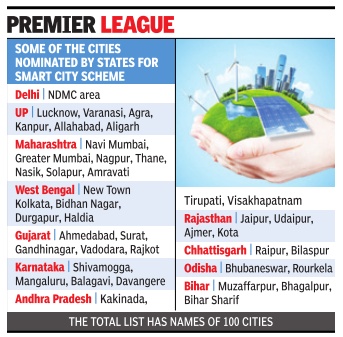
Dipak Dash
Smart city list: Smaller cousins pip metros
State capitals which include Lucknow, Mumbai, Gandhinagar, Jaipur, Vijaywada, Bhubaneswar, Raipur and Guwahati have made it to the smart cities list while Patna, Kolkata and Bengaluru have not found place in the list of top 100 nominations. All Union Territories have nominated their names, including Delhi.
Rather some of the lesser known cities and municipal areas such as Bihar Sharif in Bihar, Moradabad and Saharanpur in UP, Dharamsala in Himachal, Shivamogga in Karnataka have been nominated by the states.Sources in the urban development ministry said the big cities have not made it to the list because of the selection criteria. “States have been selected based on an objec tive mechanism. Cities with better capability to implement projects and generate their own resources have been selected. It's a move towards transparency and fair competition where none can influence the selection process,“ said an urban development ministry official.
In the first phase, Centre will pick 20 cities and in the next two years 40 cities each will be selected for receiving central funding of Rs 500 crore spread over the next five years. So, eventually all the cities and municipal areas nominated for this scheme will be developed as smart cities.
Smart cities, state-wise
Nomination of smart cities, UP
The Times of India, Aug 09 2015
Dipak Dash
Rae Bareli, Meerut tie for 13th UP slot
The race to be Uttar Pradesh's 13th smart city has ended in a tie between Meerut and Rae Bareli, and the Samajwadi Party government has decided to leave the final call to the Centre. Quite evidently, the state government appears torn between picking the bustling western UP township and Congress president Sonia Gandhi's parliamentary constituency . The Yadavs are apparently wary of displeasing Sonia by picking Meerut, which they see as their political passport to the state's western region.
The list containing names of 14 cities nominated by the UP government was discussed at a meeting recently where the apex committee also went through all the nominations from other states and Union Territories. UP was asked to nominate 13 cities as per the criteria set by the Centre in consultation with states. But it sent 14. Sources said the state's high-level committee had recorded that both the municipal areas had an equal score, which is why UP nominated two cities for the 13th position. Top officials of the UP government said they had sent the names to the Centre, and the ball was now in its court.
Sources said it would be tough for the Centre to accommodate both, since it would open the floodgates for other states to nominate more names. For example, the Jammu and Kashmir government has also been demanding an increase in its quota to two cities, since it is the only state with two capitals.
At 13, UP has the highest share of cities it can nominate, followed by TN with 12, and Maharashtra with 10. The quota was based on a formula that gives equal weight to population and the number of “statutory towns“ in each stateUT.
YEAR-WISE RANKINGS
2020
NEW DELHI: Four Indian cities — New Delhi, Mumbai, Hyderabad, and Bengaluru — witnessed a significant drop in their rankings in the global listing of smart cities that was topped by Singapore.
The Institute for Management Development (IMD), in collaboration with Singapore University for Technology and Design (SUTD), has released the 2020 Smart City Index, with key findings on how technology is playing a role in the COVID-19 era.
In the 2020 Smart City Index, Hyderabad was placed at the 85th position (down from 67 in 2019), New Delhi at 86th rank (down from 68 in 2019), Mumbai was at 93rd place (in 2019 it was at 78) and Bengaluru at 95th (79 in 2019).
"Cities in India (New Delhi, Mumbai, Hyderabad, Bengaluru) suffer significant drops this year. This can be attributed to the detrimental effect that the pandemic has had where the technological advancement was not up to date," the report said.
It further added that "Indian cities have suffered more from the pandemic because they were not prepared".
From 15 indicators that the respondents perceive as the priority areas for their city, all four cities highlighted air pollution as one of the key areas that they felt their city needed to prioritise on.
For cities like Bangalore and Mumbai, this was closely followed by road congestion while for Delhi and Hyderabad it was basic amenities, the report said.
The 2020 Smart City Index (SCI) was topped by Singapore, followed by Helsinki and Zurich in the second and the third place respectively. Others in the top 10 list include Auckland (4th), Oslo (5th), Copenhagen (6th), Geneva (7th), Taipei City (8th), Amsterdam (9th) and New York at the 10th place.
2021
Abhijeet Singh, August 20, 2021: The Times of India
In the six years since the Smart Cities Mission was launched to redevelop 100 cities across the country, just about 47% of projects have been completed, a new study by the thinktank Observer Research Foundation said.
“The progress of the Mission has been best in the states of Tamil Nadu, Madhya Pradesh and Gujarat,” the report said. “Chennai and Coimbatore in Tamil Nadu, Indore, Bhopal and Ujjain in MP, and Surat and Rajkot in Gujarat figure repeatedly among the best performers on different criteria.” Delhi and Nagaland have completed over 70% of their projects while seven other states have finished 50-60% — Rajasthan, Gujarat, Karnataka, MP, Goa, Tripura and Andhra Pradesh.
Among cities, New Delhi has the highest percentage of completed projects, followed by Chennai, Indore, Surat and Coimbatore. Rajkot utilised its funds best, followed by Indore, Ujjain, Bhopal and New Town Kolkata. At the bottom of the list project completion, among cities, are Puducherry, Amaravati, Bhagalpur, Muzaffarpur and Shillong. Not one project has been completed in these. Among states, Meghalaya has not completed a single project.
Why the disparity? “No doubt the Covid has impeded progress, but there are also various administrative and financial reasons for the underperformance,” the report said. “In some cities, the special purpose vehicles set up to implement the Mission are not functioning well due to inadequate managerial, technical, and financial capabilities. Deficiencies were observed in data handling and its analysis, levels of digitalisation, fund mobilisation, release, and utilisation.”